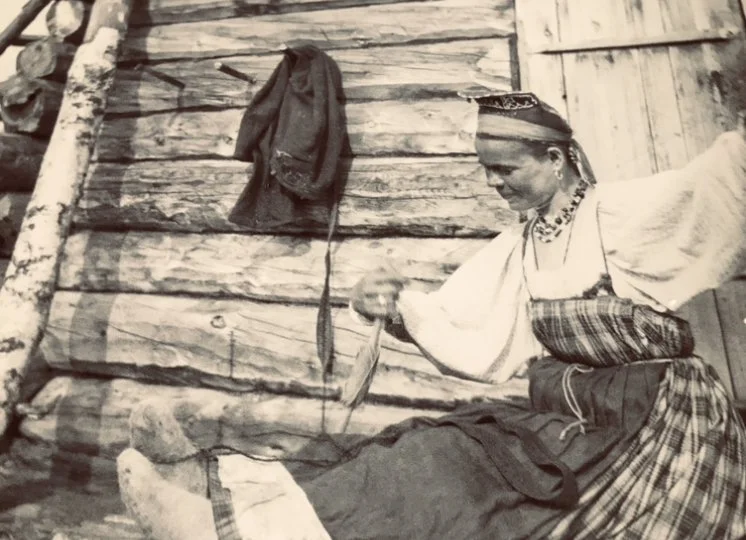Research: Kirkenes, Vadsø and Varanger
A woman from the Skolt Sámi community, near Kirkenes, preparing wool.
The research trip to Kirkenes, Vadsø and Varanger was the starting point of a larger project within the Norwegian Network for Costume and Textiles which focuses on dress, identity and dialogue. It also fed into preliminary work for the developing project on Scottish and Norwegian dress and textiles. I was lucky enough to be invited to join this visit in April 2025, learning alongside dress, textile and museum specialists from various parts of Norway including Valdres, Stavanger, Oslo and Bergen.
In essence, Norway’s Network for Costume and Textiles recognises a significant lack of knowledge about sartorial traditions - despite the nation’s ongoing love of and use of costume - as well as a limited understanding of the importance and potential of costume collections as historical sources. The aim of the visit was to stimulate dialogue between various museums in Norway - based in the far north and further south of this vast country - that actively work with dress and clothing, and require further knowledge about the historic and continued use of dress and folk costume in today’s society. In Norway, it is understood that for museums to function as relevant actors in a world where globalisation and technology are fast-eroding or replacing traditional skills and inherited knowledge, it is important they manage their textile collections well, with expertise and confidence. Equally important is the ability of museums to view both Norwegian and Sámi costume collections in relation to current events and cultural phenomena.
The visit focused on meetings and conversations with practitioners and craftspeople in traditional areas in both Norway and Sápmi, with the goal of fostering dialogue and a new understanding of these traditional expressions, as craft and a powerful symbol of identity. Travelling by bus and the Arctic cruise line Hurtigruten, we explored four important museums to stimulate discussion and further understanding.
Ä´vv Saa´mi Mu´zei Skolt Sámi Museum is a cultural-historical museum that conveys Skolt Sámi history. The Skolt Sámi are the indigenous people of the border area between Norway, Finland and Russia. The museum, a stunning one-story wooden construction, is located in Njauddâm/Neiden and opened in 2017. It aims to contribute to the strengthening of Skolt Sámi culture, language and identity, as well as to conveying knowledge about the Skolt Sámi past and present. The permanent exhibition is divided into three separate rooms: in the first, visitors find information on how the communities organised themselves, as well as traditions and cultural roots; the second addresses how different seasons have influenced the Skolt Sámi way of life - a nomadic lifestyle between seasonal settlements - and what the most important resources are at different times of the year; the final room shows how the outside world has brought new influences, changes and difficulties to the Skolt Sámi Land. Here, the question of indigenous rights is also discussed.
The Várjjat Sámi Musea/Varanger Sámi Museum communicates the coastal Sámi history and culture, the prehistory of Finnmark and Sámi textiles, dress, and handicraft – duodji. The main themes of the exhibitions are Prehistory, Sámi faith and mythology, pre-colonial Sámi society and the primary economies: reindeer herding, fishing and animal husbandry. The main building of the museum displays architecture based on Sámi house building traditions. It contains the main exhibition The Coastal Sámi, the children´s play room “Stallobiedju” (The lair of Stallo), and a temporary exhibition on highly intricate, colourful belts and ribbons.
The Vadsø Museum - Ruija Kvenmuseum - is a local museum, with a national responsibility for Kven/Norwegian-Finnish history. Kvens and Norwegian Finns are descendants of people who came from Finnish-speaking areas before World War II. Today, this ethnic group has the status of a national minority, and their language – Kven – is a separate language. The museum's basic exhibition tells more about the Kven/Norwegian-Finnish history, which is both complicated and, at times, politicised. Vadsø municipality is in a unique position in Finnmark in terms of preserved older pre-war buildings. Around 700 buildings survived World War II. The museum's various historical facilities show Vadsø as a fishing village, agricultural area, trading and administrative town. Tuomainengården in Ytrebyen and Bietilægården, with a quay in Indrebyen, explain the building customs and culture of the Kvens and Norwegian Finns. At Tuomainengården it is possible to explore the house, barn, stable, forge, bakery and sauna as a ‘living museum’ - whilst visiting, we were lucky enough to be served a meal by the Museum’s curators.
The Borderland Museum in Kirkenes narrates the complex border history of South Varanger, a multicultural community with Finland to the west and Russia to the east. Here, Curators and local Sami craftspeople demonstrated traditional crafts, and spoke about how to work with collections in an area with multi- national cultures.
